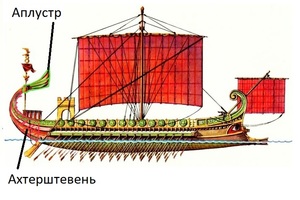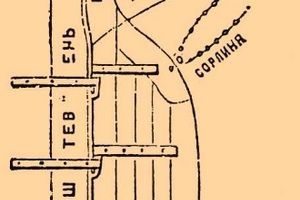Achtersteven
Achtersteven (Dutch: achtersteven - literally "rear post") is the rear end of a ship, typically in the form of a rigid beam or frame to which the rudder is attached. The frame of the hull, side, and keel of the ship are vertically connected to this part. As the origin of the name suggests, the term is modern and pertains to later eras, though technically similar elements existed on ancient ships.
In antiquity, the achtersteven was typically made of wood, selected with particular attention to strength and durability. In Ancient Greece and Rome, oak was often used for this purpose due to its robustness and resistance to water.
The construction of the achtersteven was relatively simple but required a high level of craftsmanship. It was attached to the keel and the side hull of the ship, providing rigidity and stability to the stern. The rudder, which was used to steer the ship, was often mounted on the upper part of the achtersteven. This design allowed ancient vessels to maneuver successfully in challenging maritime conditions.
In antiquity, the achtersteven served several key functions:
- Structural support: The achtersteven connected and reinforced various parts of the ship, especially at the rear where the rudder was attached. This provided overall structural integrity to the vessel, crucial for its buoyancy and reliability.
- Steering: Attaching the rudder to the achtersteven allowed for more precise control of the ship's movement. In antiquity, rudders were relatively simple, usually consisting of a large flat board mounted vertically and manually operated.
- Hydrodynamic shape: An important aspect of the achtersteven was its role in shaping the stern of the vessel, influencing the ship's hydrodynamic properties. A smooth, streamlined shape reduced water resistance, contributing to increased speed and maneuverability of the vessel.
- Ancient shipbuilding underwent significant changes, and the achtersteven evolved along with it. The earliest forms of achterstevens can be found on Egyptian vessels and Phoenician galleys, where they consisted of a simple wooden beam. Over time, with the advancement of technology and the increasing complexity of seafaring, achtersteven structures became more complex and functional.
In Ancient Rome, the achtersteven often featured decorative elements symbolizing the power and prestige of the ship. Some Roman vessels, such as military galleys, were adorned with reliefs and decorations on the achtersteven, adding not only functionality but also aesthetic value to the ship.
Related topics
Aplustre, Castrum, Trireme, History of the Republican Navy of Ancient Rome, Composition of the Ancient Roman Military Fleet,




